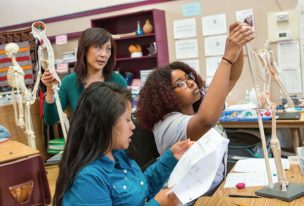The Critical Missing Piece in Developing Teacher Learning: Creating Opportunities for Understanding
In this article on developing deep teacher learning, Mills Teacher Scholars’ Executive Director Carrie Wilson calls for an increased attention to creating the time and support for teachers to make sense of the practices they are implementing and their impact on students.
As those of us who came to education with a social justice framework know, understanding is the pathway to agency. 21st Century Learning and the Common Core are giving greater emphasis to understanding and “deeper learning” for students. There is a refreshing insistence that students must be able to do something with what they know. Their knowledge must be deep and their understanding must be flexible. But what about teacher learning and teacher knowledge? What do teachers have to know in order to create learning opportunities for students that allow for deeper learning? And what opportunities do they need to learn this?
This month Mills Teacher Scholars published two rich blog posts from Oakland Unified teacher scholars Laura Alvarez and Michelle Cascio that help us answer that question. Their Teacher Scholars’ work sheds light on two important—and often overlooked—requirements for teacher learning: time and support. Teachers need both time and support to clarify their desired learning goals and to make sense of what is happening for students. They need time to think– both alone and with colleagues.
In her blog Laura distinguishes between “understanding the story” and “understanding the text” by listening to how her students talk in book groups and by thinking it over with colleagues in her Mills Teacher Scholars sessions. By listening to her students talk about literature, Michelle realizes that though they are widely considered to be best practice, insisting that her students use stock sentence frames constrains her students’ thinking and language rather than expands it. Through the insights and understanding that occur when looking at data with colleagues, Laura and Michelle developed a deeper understanding both of their learning goal for students and of what opportunities would allow students to reach the refined goals.
Laura and Michelle’s insights into developing student learning are nuanced and effective, yet the process that got them there—systematically analyzing what is happening for students with cross-grade colleagues —is surprisingly rare. While teachers routinely plan together, and frequently come together to review formative assessments to name where students are in their proficiency, they seldom have time to investigate what causes their students to perform as they do—and what gets in the way when their performance is below what it ought to be. Instead of teachers grappling over questions such as what high quality book groups sound like, teachers’ professional learning time is more likely spent receiving “best practices” and “high leverage strategies.”
 While learning these strategies is necessary as teachers create their instructional plans, unless they have time to try these “best practices” out and determine if they are “best” and for whom, there is no assurance that the strategies are improving learning opportunities for students. We have long known that this banking model of learning—where the learner (in this case the teacher) is filled with knowledge—is ineffective. It is as ineffective for teachers as it is for students. Yet for teacher professional development, this banking model persists. What we know about the complexities of great teaching—differentiation, deep understanding of content goals, cultural responsiveness, etc.—assumes a professional learning culture that, for most urban schools, has yet to be nurtured.
While learning these strategies is necessary as teachers create their instructional plans, unless they have time to try these “best practices” out and determine if they are “best” and for whom, there is no assurance that the strategies are improving learning opportunities for students. We have long known that this banking model of learning—where the learner (in this case the teacher) is filled with knowledge—is ineffective. It is as ineffective for teachers as it is for students. Yet for teacher professional development, this banking model persists. What we know about the complexities of great teaching—differentiation, deep understanding of content goals, cultural responsiveness, etc.—assumes a professional learning culture that, for most urban schools, has yet to be nurtured.
Teachers at Mills Teacher Scholars partner sites work in cross-grade level teams. As they analyze meaningful classroom learning data together they move from having broad goals for student learning and a general knowledge of what is happening for students to developing clear and explicit indicators for student success and specific understanding of how their instructional strategies work (or don’t work) to help students achieve that success.
The missing piece in teacher learning initiatives is providing this time and support for teachers to make sense of their teaching and of their students’ learning. Often the end goal of districts’ learning plans for teachers is to relay the latest ideas about what research says they “should do.” Rather than that as an end goal, for us at Mills Teacher Scholars, this is our starting place.


